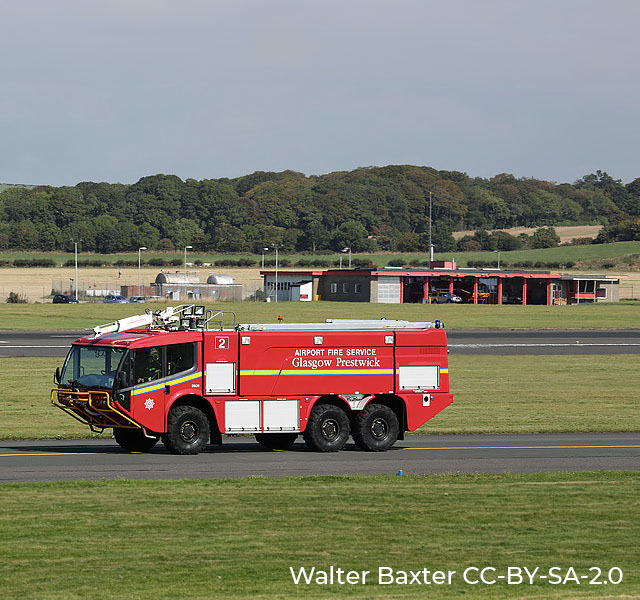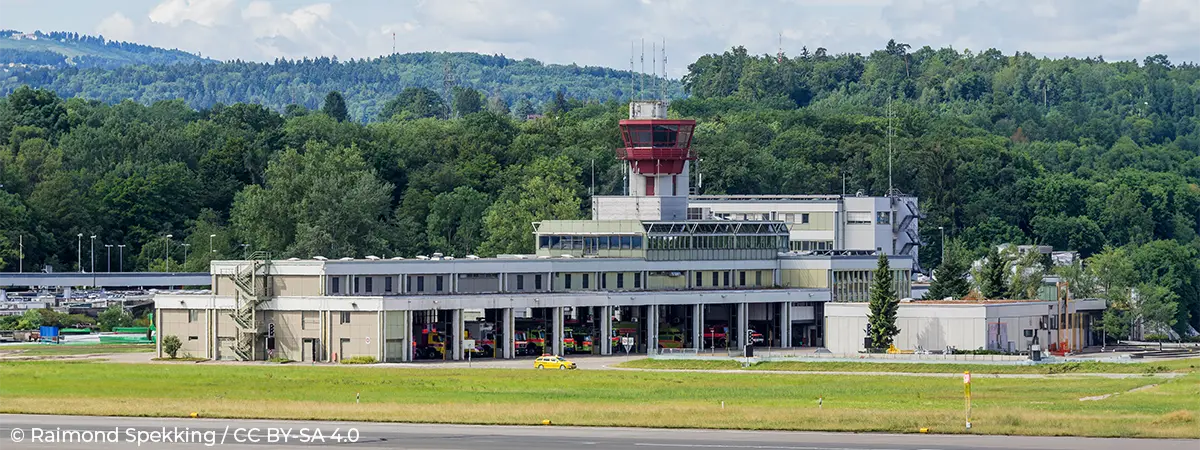You’ve probably seen them at one time or another and you might have asked yourself whether the firefighters at an airport work the same way firefighters at your local fire station work. If you’re a frequent flier, you might have even seen a drill of them extinguishing a fire set in an old aircraft whose fuselage is used for this purpose.
You also likely remember an image of water cannons making an arch over a plane that just landed, either to celebrate a sporting event or to inaugurate an air route.
Proper design and availability of this equipment is essential for the certification of the infrastructure and the operations authorisation at an airport.
If you’re very observant during take-off, you may have noticed them working out intensely next to the building where their recognisable firefighting vehicles are kept.
Even if you are a regular at an airport where snow usually plays a major role, you can find them ploughing the white stuff from the taxiway or runway itself.
Of course, if you’re in the business of designing airports, you’ve definitely met with an official from the fire department, as their contribution to how to make certain components available and how to simulate their operation in the event of an emergency is essential to properly designing the space.
We’re naturally talking about the Firefighting Service also known as the airport Fire Rescue Station.
But how are these buildings designed? What components comprise it? Why do they tend to look the same wherever you fly?
This post provides our perspective on all of this, discussing the regulated aspects and those that to some extent solely depend on the designer.
How is an FRS designed?
Regulating how the firefighting service acts in case of accident or potential emergency is naturally subject to precise and strict regulations. Proper design and availability of this equipment is essential for the certification of the infrastructure and the operations authorisation at an airport. That’s why the ICAO determines the components an FRS must have based on the category of airport. This aspect – the category – in turn, comes mainly from the type of aircraft that can operate at the airport.
There are essentially four elements dictating a FRS’s category:
- The number of emergency vehicles that must be in operation.
- The volume of the extinguishing agent available for the vehicles and reloading in emergency operations.
- The number of firefighters the facilities should be designed for.
- And finally, the equipment that said crew needs to have available in the building at all times.
These are essentially the components to be considered when designing a building of this nature. Let’s take a look at how it’s done.
Locating the FRS
First, the location of the FRS must be chosen very carefully. From the regulatory perspective, in the event of an emergency, emergency vehicles cannot take more than 3 minutes to reach the furthest away point of the airfield. Ideally, that period of time should not exceed two minutes. The furthest point is usually the end of the runway, at both ends, so designers tend to locate the station at a point between the two.
There also needs to be a direct connection between the area where the vehicles are parked and the runway itself. This is usually an access road as close as possible to the building, with as few unnecessary turns as possible.
In terms of the FRS location, visibility must also be considered. Observation of the entire airfield and the majority of the airport’s area of movement must be guaranteed. Generally, a high point is designed in the building to be used as the AOC, airport observation centre, a place where a potential incident can be identified if it hasn’t already been.
Equipping the FRS
The general size and organisation of the FRS mostly comes from the number of vehicles that it must house and its equipment.
The vehicles take up the largest amount of space in the building, kept safe from the elements. Generally, this piece is the one “placed” first, as its proper location depends largely on the aspects explained previously. This is not only due to its connection to the access road to the airfield, but also – if the operation of refilling the vehicle with extinguishing agent is carried out – due to the manoeuvring vehicles need to do around the building to complete the refilling operation.
 Moreover, as is logical, the “warehouse” holding the emergency vehicles must be properly sized to hold as many vehicles as required by regulations based on the airport category. Additionally, best practices recommend leaving space for at least one more, ensuring that the warehouse can be easily expanded in the future. At least one of the parking bays must be equipped with a trench for any maintenance that needs to be carried out on the vehicles.
Moreover, as is logical, the “warehouse” holding the emergency vehicles must be properly sized to hold as many vehicles as required by regulations based on the airport category. Additionally, best practices recommend leaving space for at least one more, ensuring that the warehouse can be easily expanded in the future. At least one of the parking bays must be equipped with a trench for any maintenance that needs to be carried out on the vehicles.
Emergency work depends largely on the vehicles. Having the right number, in the right condition, available and in the right position is critical.
The next component of concern after locating the building and having designed the “garage” is usually equipping it properly. In turn, this aspect has facets:
On the one hand, the firefighters’ equipment and, on the other, the vehicles’.
For the former, all the components needed for the firefighters’ jobs must be stored here. This equipment therefore needs to be easily accessible, located in properly sized places, and it must have shelter and all of these components must be properly preserved. This refers to bunker gear, canisters, mechanical components, etc.
The next central figure is the extinguishing agent. Based on the type of agent, it must be preserved under a specific set of conditions. In this area, on the one hand, volume is essential, and on the other, so is availability so that refilling can be done quickly and safely. One of the most common ways to ensure this is by designing a raised tank next to the FRS, carefully analysing the movement of the vehicles in the above-mentioned vehicle refilling processes.
Finally, in terms of the equipment, logically, the building must have the right number of rooms for the firefighters to be able to properly do their work both during emergencies and everyday activities. There are essentially four of these tasks: operations management, training, rest and, of course, emergency operations.
These are the rooms that help to protect the vehicles and FRD equipment. Offices, training rooms, spaces for physical training, locker rooms and rest areas “round off” the design of this building.
Interestingly, these areas, the ones used most and where the firefighters spend hundreds of hours per year, are the ones that are least regulated and tend to have the greatest “local” flavour. Thus, we’ll leave those for the end of this article.
Vehicles, equipment and people are what offer us the keys to make all the FRS rooms “functional”. However, there are other aspects that must be present in a “good project”.
Connecting the FRS
Fortunately, there are few times in which there is an emergency in an airport. But when that circumstance arises, quick intervention of emergency services is essential to preventing or at least minimising the impact this situation may cause fundamentally to people, (but also, logically, to aircraft and infrastructure). For this, facilities must be robust and guarantee the entire process will function perfectly. Above all, it must guarantee communication flows.
As mentioned previously, the role of the AOC is critical to raising the alarm on an emergency. Or, in the opposite sense, the voice of alarm issued by the airport operations centre or the control tower must arrive unambiguously and directly to the FRS. That’s why the design of the communications system is one of the critical points of a project of this nature.
Similarly, however, all other services must be guaranteed at the FRS. That is why double supply of electricity and water is a common measure on these types of projects.
Under no circumstance can electricity, water supply or communications fail in this building. That is why having alternative routes for these components is imperative when designing a FRD in case of any unexpected occurrence.
Humanising the FRS
The aspects described up to this point are generally regulated and mandatory. If the designer follows the regulations, as of course they must, these aspects are included by default. However, simply complying with regulations is an error, because the FRS is a place where many professionals spend a lot of time. There, in addition to acting in the event of an emergency, they need to train, cohabitate, rest and, to a certain extent, be bored for long periods of time.
The design of the FRS is governed nearly 100% by a circumstance that hardly ever actually occurs. That’s why, once all of these aspects have been guaranteed, designers must think about the comfort of the people using the building. It isn’t appropriate to only pay attention to the regulatory aspects governing the space in case of emergency, while forgetting the remaining 99.9% of the time “our protectors” have to spend there.
Too often we visit fire rescue stations designed “solely” for the vehicles and their important cargo, with very little thought going to the firefighters. These buildings offer quite dubious conditions for living and resting and improvised spaces for firefighters to train, with no or insufficient “non-essential” equipment.
Large, well-equipped, well-ventilated, properly lit rest areas, equally well-lit work spaces for individual concentration, and also for teamwork, are needed. Firefighters also need small gyms where they can properly train, not just indoors, but also outdoors with areas equipped for that training.
Thus, an appropriate approach to “non-critical” rooms, good acoustics and heating/cooling conditions that allow the relevant activities to take place in each space and pleasant architecture are the best guarantee to ensure these professionals are ready to, hopefully, never have to do their jobs.



